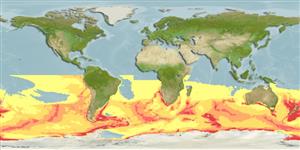Common names from other countries
Classification / Names / Names
Nomi Comuni | Sinonimi | Catalog of Fishes (gen., sp.) | ITIS | CoL | WoRMS
Environment: milieu / climate zone / depth range / distribution range
Ecologia
Batidemersale. Polar; 0°N - 90°S, 180°W - 180°E
Indo-Pacific, Atlantic Ocean, and the Antarctic.
Length at first maturity / Size / Peso / Age
Maturity: Lm ? range ? - ? cm Max length : 300 cm TL maschio/sesso non determinato; (Ref. 1394); 360 cm TL (female); Peso massimo pubblicato: 450.0 kg (Ref. 1394); Peso massimo pubblicato: 450.0 kg
Found throughout the pack ice zone; haul out on ice and land, often preferring ice floes, when available. Feeds on krill, fish, squid, penguins, and young seals, and will occasionally scavenge from carcasses of whales (Ref. 1394). Found throughout the pack ice zone; haul out on ice and land, often preferring ice floes, when available. Feeds on krill, fish, squid, penguins, and young seals, and will occasionally scavenge from carcasses of whales (Ref. 1394).
Jefferson, T.A., S. Leatherwood and M.A. Webber. 1993. (Ref. 1394)
IUCN Red List Status (Ref. 130435)
CITES status (Ref. 108899)
Not Evaluated
Not Evaluated
Human uses
Pesca: commerciale
FAO - pesca: species profile | FishSource | Sea Around Us
Strumenti
Fonti Internet
Estimates based on models
Preferred temperature
(Ref.
115969): -1.9 - 1.4, mean -0.5 (based on 2109 cells).
Resilienza
Alto, tempo minimo di raddoppiamento della popolazione meno di 15 mesi (K=0.36-0.47).
Vulnerability
Very high vulnerability (90 of 100).
Price category
Unknown.
